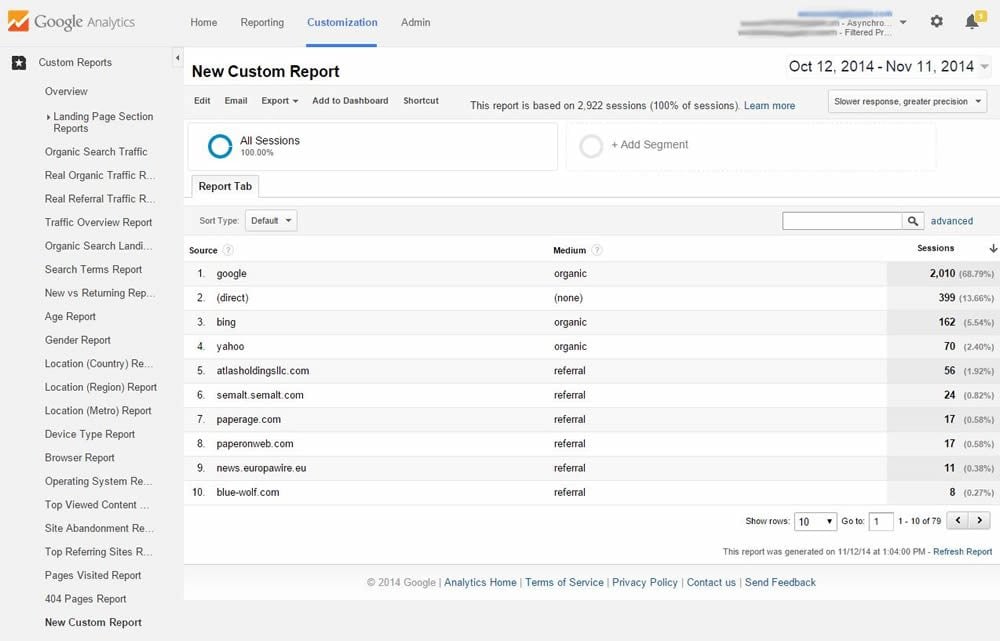Make Best Use Of Reporting Precision With Secondary Dimension in Google Analytics
Understanding how to optimize reporting accuracy with secondary dimensions in Google Analytics can substantially boost the deepness of insights obtained from data analysis. By integrating additional dimensions strategically, online marketers can discover covert patterns and connections that may not be quickly evident when evaluating main metrics alone.
Comprehending Additional Dimensions in Google Analytics
Second dimensions permit users to sector and better explore data past the primary dimension selected. While the key measurement may show the complete number of page sights, including a second dimension such as 'source/medium' can supply insights right into where the web traffic stemmed from.
Furthermore, recognizing additional measurements is vital for developing much more personalized records customized to specific company objectives. By picking the right combination of main and additional measurements, analysts can uncover patterns, trends, and connections that may otherwise stay concealed. This nuanced strategy to data analysis empowers companies to make informed decisions based on a detailed understanding of customer actions throughout numerous dimensions.
Just How to Apply Secondary Measurements
When leveraging additional dimensions in Google Analytics, the practical application involves picking details data parameters to more fine-tune insights past the key dimension's scope. To use additional dimensions efficiently, begin by accessing the report or dataset where you want to dive much deeper into the information. Keep in mind that secondary measurements assist offer context and granularity to your key dimension data, allowing you to extract even more actionable and purposeful insights from your Google Analytics records.
Leveraging Additional Measurements for Insights
Using second measurements in Google Analytics permits an extra detailed evaluation of data, providing valuable understandings past the main measurement's scope. By leveraging second dimensions, customers can dig much deeper into the performance metrics of their internet site or app, revealing covert patterns and fads that may not be immediately obvious when just taking a look at key dimensions.
One secret benefit of making use of secondary dimensions is the capacity to section and filter information more exactly. This can aid marketing professionals and experts better comprehend the habits of details customer sections, such as brand-new site visitors versus returning site visitors, or website traffic originating from various geographical areas.
Additionally, additional dimensions allow users to contrast and comparison numerous data factors within the exact same record, supplying a much more alternative view of performance (Secondary Dimension in Google Analytics). For instance, combining the main dimension of landing web pages with second measurements like tools or demographics can expose which pages are most effective in involving customers on various tools or from different demographic teams.
Essentially, leveraging additional dimensions in Google Analytics empowers individuals to draw out richer understandings from their information, bring about more informed decision-making and inevitably, enhanced performance.
Best Practices for Secondary Measurements
When assessing data in Google Analytics, integrating additional measurements effectively improves the deepness of understandings derived from the main metrics. Picking pertinent secondary measurements assists in offering context and a more clear understanding of the information being examined.
Additionally, it is suggested to moved here restrict the variety of second dimensions used in a single report to prevent frustrating the analysis with way too much info. Concentrating on a couple of vital secondary dimensions each time can bring about more concentrated and workable understandings. In addition, think about try out various mixes of key and second measurements to discover special patterns and patterns that might not appear when looking at the data in isolation.
Advanced Evaluation Methods With Second Measurements
Checking out elaborate data relationships through the strategic application of secondary dimensions can introduce nuanced understandings that boost the deepness of analysis in Google Analytics. By integrating additional dimensions with main data collections, innovative evaluation methods can be utilized to extract important information. One such technique is accomplice analysis, where click here to read second measurements allow for the segmentation of customers right into teams sharing common qualities. This method enables a deeper understanding of user habits patterns in time, aiding in the recognition of trends and the analysis of advertising and marketing campaigns' effectiveness.
Furthermore, second dimensions can improve the analysis of conversion paths by giving extra context. Understanding the different touchpoints a customer communicates with prior to converting can be critical in optimizing the consumer journey - Secondary Dimension in Google Analytics. By making use of secondary dimensions to look into specifics such as web traffic resources or devices utilized, online marketers can customize strategies to target high-converting channels successfully
Verdict

To enhance data analysis and gain much deeper understandings into individual habits, recognizing secondary dimensions in Google Analytics is imperative - Secondary Dimension in Google Analytics. Additional measurements permit users to segment and even more explore information past the key measurement picked. While the primary measurement may display the total number of web page sights, including a secondary measurement such as 'source/medium' can provide insights into where the web traffic originated from.When leveraging secondary dimensions in Google Analytics, the functional application read review involves selecting specific information parameters to additional refine understandings past the primary dimension's range. Keep in mind that second measurements aid supply context and granularity to your main measurement information, allowing you to remove even more purposeful and workable insights from your Google Analytics reports